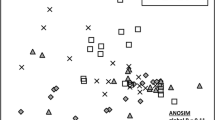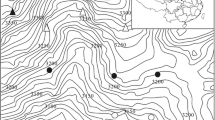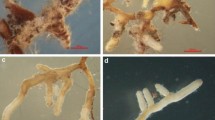Abstract
Ectomycorrhizal fungi constitute an important component of soil biota in Nothofagus forests in Patagonia. However, ectomycorrhizal fungal community is poorly known in this region. Here, we assess biodiversity and community compositions of ectomycorrhizal fungal species associated with Nothofagus dombeyi, N. obliqua and N. alpina. We selected three monospecific Nothofagus forest sites for each species within the boundaries of the Lanin National Park in Northern Patagonia. Ectomycorrhizal fungal species were identified based on morphotyping and rDNA (ITS and 28S rDNA) sequence analysis using both universal and taxon-specific primers. Contrary to previous studies on congeneric host trees, our results showed no significant differences among Nothofagus forest types in terms of fungal biodiversity and community composition. However, altitude had a strong effect on the structure of the ectomycorrhizal fungal community associated with Nothofagus spp.



Similar content being viewed by others
References
Abarenkov K, Henrik Nilsson R, Larsson K, Alexander I, Eberhardt U, Erland S, Høiland K, Kjøller R, Larsson E, Pennanen T, Sen R, Taylor A, Tedersoo L, Ursing B, Vrålstad T, Liimatainen K, Peintner U, Kõljalg U (2010) The UNITE database for molecular identification of fungi—recent updates and future perspectives. New Phytol 186:281–285. doi:10.1111/j.1469-8137.2009.03160.x
Aerts R (1995) The advantages of being evergreen. Trends Ecol Evol 10:402–407
Agerer R (1991) Characterization of Ectomycorrhiza. In: Norris J, Read D, Varma A (eds) Techniques for the study of mycorrhiza, methods in microbiology. Academic, London, pp 25–73
Aponte C, Garcia L, Marañon T, Gardes M (2010) Indirect host effect on ectomycorrhizal fungi: leaf and litter quality explain changes in fungal communities on the roots of co-occurring Mediterranean oaks. Soil Biol Biochem 42:788–796
Bahram M, Põlme S, Kõljalg U, Zarre S, Tedersoo L (2012) Regional and local patterns of ectomycorrhizal fungal diversity and community structure along an altitudinal gradient in the Hyrcanian forests of northern Iran. New Phytol 193:465–473
Bruns TD (1995) Thoughts on the processes that maintain local species diversity of ectomycorrhizal fungi. Plant Soil 170:63–73
Cabrera A (1976) Regiones Fitogeográficas Argentinas. Enciclopedia Argentina de Agricultura y Jardinería. ACME, Buenos Aires
Cavender-Bares J, Izzo A, Robinson R, Lovelock CE (2009) Changes in ectomycorrhizal communities structure on two containerized oak host across an experimental hydrologic gradient. Mycorrhiza 19:133–142
Claridge A, Robinson A, Tanton M, Cunningham R (1993) Seasonal production of hypogeal fungal sporocarps in a mixed-species eucalypt forest stand in South-eastern Australia. Aust J Bot 41:145–167
Colwell R (2006). EstimateS: Statistical estimate of species richness and shared species from samples, version 8.0. http://purl.oclc.org/estimates. Accessed 20 July 2009.
Dahlberg A (2001) Community ecology of ectomycorrhizal fungi: an advancing interdisciplinary field. New Phytol 150:555–562
Diehl P, Mazzarino M, Funes F, Fontenla S, Gobbi M, Ferrari J (2003) Nutrient conservation strategies in native Andean-Patagonian forests. J Veg Sci 14:63–70
Diehl P, Mazzarino M, Fontenla S (2008) Plant limiting nutrients in Andean-Patagonian woody species: effects of interannual rainfall variation, soil fertility and mycorrhizal infection. For Ecol Manage 255:2973–2980
Dickie I, Richardson S, Wiser S (2009) Ectomycorrhizal fungal communities and soil chemistry in harvested and unharvested temperate Nothofagus rainforests. Can J For Res 39:1069–1079
Di Rienzo J, Robledo W, Casanoves F, Balzarini M, González L, Guzmán A, Tablada E (2001). Infostat. Versión Beta. Estadística y Biometría, Facultad de Ciencias Agropecuarias, Universidad Nacional de Córdoba, Córdoba.
Fontenla S, Godoy R, Rosso P, Havrylenko M (1998) Root associations in Austrocedrus chilensis forests and seasonal dynamics of arbuscular mycorrhizas. Mycorrhiza 8:29–33
Gardes M, Bruns TD (1996) Community structure of ectomycorrizal fungi in a Pinus muricata forest: above- and below-ground views. Can J Bot 74:1572–1583
Garnica S, Weiß M, Oberwinkler F (2003) Morphological and molecular phylogenetic studies in South American Cortinarius species. Mycol Res 107:1143–1156
Garrido N (1988) Agaricales s.l. und ihre Mykorrhizen in der Nothofagus-Waldern Mittelchiles. Bibl Mycol 120:1–528
Gomez-Hernandez W-LG, Guevara R, Lodge DJ (2012) Patterns of macromycete community assemblage along an elevation gradient: options for fungal gradient and metacommunity analyses. Biodiv Conserv 21:2247–2268
Horak E (1977) New and rare Boletes from Chile. Bol Soc Arg Bot 18:97–109
Horak E (1979) Fungi, Basidiomycetes, Agaricales y Gasteromycetes secotioides. Flora Cript Tierra del Fuego 11:1–525
Horak E, Moser M (1966) Fungi Austroamericani VIII. Uber neue Gastroboletaceae aus Patagonien: Singeromyces Moser, Paxillogaster und Gymnopaxillus Horak. Nova Hedw 10:329–338
Horton T, Bruns TD (1998) Multiple-host fungi are the most frequent and abundant ectomycorrhizal types in a mixed stand of Douglas fir (Pseudotsuga menziesii) and bishop pine (Pinus muricata). New Phytol 139:331–339
Horton T, Bruns TD (2001) The molecular evolution in ectomycorrhizal ecology: peeking into the black box. Mol Ecol 10:1855–1871
Hunt GA, Trappe JM (1987) Seasonal hypogeous sporocarps production in a western Oregon Douglas-fir stand. Can J Bot 65:438–445
Ishida T, Nara K, Hogetsu T (2007) Host effects on ectomycorrhizal fungal communities: insight from eight host species in mixed conifer–broadleaf forests. New Phytol 147:430–440
IUSS Grupo de Trabajo WRB (2007). Base Referencial Mundial del Recurso Suelo. Primera actualización 2007. Informes sobre Recursos Mundiales de Suelos No. 103. FAO, Rome.
Johnson CN (1994) Fruiting of hypogeous fungi in dry sclerophyll forest in Tasmania, Australia: seasonal variation and annual production. Mycol Res 98:1173–1182
Kennedy PG, Izzo AD, Bruns TD (2003) There is a high potential for the formation of common mycorrhizal networks between understory and canopy trees in a mixed evergreen forest. J Ecol 91:1071–1080
Kohout P, Sýkorová Z, Bahram M, Hadincová V, Albrechtová J, Tedersoo L, Vohník M (2011) Ericaceous dwarf shrubs affect ectomycorrhizal fungal community of the invasive Pinus strobus and native Pinus sylvestris in a pot experiment. Mycorrhiza 21:403–412
Molina R, Massicotte H, Trappe JM (1992) Specificity phenomena in mycorrhizal symbiosis: community-ecological consequences and practical implications. In: Allen M (ed) Mycorrhizal functioning. An integrative plant-fungal process. Chapman and Hall, New York, pp 357–423
Moreira-Muñoz A (2004) Nothofagus Bl., pieza clave en la reconstrucción de la biogeografía del hemisferio austral. Rev Chagual 2:15–25
Morris M, Smith M, Rizzo D, Rejmánek M, Bledsoe C (2008) Contrasting ectomycorrhizal fungal communities on the roots of co-occurring oak (Quercus spp.) in a California woodland. New Phytol 178:167–176
Morris M, Perez-Perez M, Smith M, Bledsoe C (2009) Influence of host species on ectomycorrhizal communities associated with two co-occurring oaks (Quercus spp.) in tropical cloud forest. FEMS Microbial Ecol 69:274–287
Moser M, Horak E (1975) Cortinarius Fr. und nahe verwandte Gattungen in Südamerika. Nova Hedw 52:628
Nara K (2006) Ectomycorrhizal networks and seedling establishment during early primary succession. New Phytol 169:169–178
Nouhra E, Urcelay C, Longo S, Fontenla S (2012a) Differential hypogeous sporocarp production from Nothofagus dombeyi and N. pumilio forests in southern Argentina. Mycologia 104:45–52
Nouhra E, Hernandez L, Pastor N, Crespo E (2012b) The species of Scleroderma from Argentina, including a new species from the Nothofagus forest. Mycologia 104:488–495
Oksanen J,Blanchet G,Kindt R,Legendre P,Minchin P R, O’HaraB, Simpson G L, SolymosP, Stevens M H, Wagner H (2010). Vegan: community ecology package version 2.0.0. http://CRAN.R-project.org/package=vegan
Palfner G (2005) Tylopilus temucensis sect. Oxydabiles (Fungi, Basidiomycota, Boletaceae), new species and first record of the genus from South American Nothofagus forest. Fungal Diversity 20:157–166
Palfner G, Canseco M, Casanova-Katny A (2008) Post-fire seedlings of Nothofagus alpina in Southern Chile show strong dominance of a single ectomycorrhizal fungus and a vertical shift in root architecture. Plant Soil 313:237–259. doi:10.1007/s11104-008-9697-y
Pirozynski KA (1983) Pacific mycogeography: an appraisal. Aus J Bot 10:137–159
Richard F, Millot S, Gardes M, Selosse MA (2005) Diversity and specificity of ectomycorrhizal fungi retrieved from an old-growth Mediterranean forest dominated by Quercus ilex. New Phytol 166:1011–1023
Sabatier Y, Azpilicueta M, Marchelli P, González-Peñalba M, Lozano L, García L, Martinez A, Gallo L, Umaña F, Bran D, Pastorino J (2011) Distribución natural de Nothofagus alpina y Nothofagus obliqua (Nothofagaceae) en Argentina, dos especies de primera importancia forestal de los bosques templados norpatagónicos. Bol Soc Arg Bot 46:131–138
Satti P, Mazzarino M, Bobbi M, Funes F, Roselli L, Fernandez H (2003) Soil N dynamics in relation to leaf litter quality and soil fertility in north-western Patagonian forests. J Ecol 91:173–181
Smith SE, Read DJ (2008) Mycorrhizal symbiosis. Academic, Great Britain
Smith SE, Douhan G, Rizzo D (2007) Ectomycorrhizal community structure in a xeric Quercus woodland based on rDNA sequence analysis of sporocarps and pooled roots. New Phytol 174:847–863
Smith SE, Fermier A, Rizzo D (2009) Are true multihost fungi the exception or the rule? Dominant ectomycorrhizal fungi on Pinus sabiniana differ from those on co-occurring Quercus species. New Phytol 182:295–299
Smith J, Molina R, Huso M, Luoma D, Mc Kay D, Castellano M, Lebel T, Valachovic Y (2002) Species richness, abundance and composition of hypogeous and epigeous ectomycorrhizal fungal sporocarps in young, rotation-age and old-growth stands of Douglas-fir (Pseudotsuga menziesii) in the Cascade Range of Oregon. USA Can J Bot 80:186–204
Taylor AFS, Martin F, Read DJ (2000) Fungal diversity in ectomycorrhizal communities of Norway spruce (Picea abies) and beech (Fagus sylvatica) along north–south transects in Europe. Ecol Studies 142:343–365
Tedersoo L, Hansen K, Perry AA, Kjoller R (2006) Molecular and morphological diversity of pezizalean ectomycorrhiza. New Phytol 170:581–596
Tedersoo L, Jairus T, Horton B, Abarenkov K, Suvi T, Kõljalg U (2008) Strong host preference of ectomycorrhizal fungi in a Tasmanian wet sclerophyll forest as revealed by DNA barcoding and taxon-specific primers. New Phytol 180:479–490
Tedersoo L, Gates G, Dunk C, Lebel T, May TW, Kõljalg U, Jairus T (2009) Establishment of ectomycorrhizal fungal community on isolated Nothofagus cunninghamii seedlings regenerating on dead wood in Australian wet temperate forests: does fruit-body type matter? Mycorrhiza 19:403–416
Tedersoo L, May T, Smith M (2010) Ectomycorrhizal lifestyle in fungi: global diversity, distribution, and evolution of phylogenetic lineages. Mycorrhiza 20:217–263
Tedersoo L, Bahram M, Jairus T, Bechem E, Chinoya S, Mpumba R, Leal M, Randrianjohany E, Razafimandimbison S, Sadam A, Naadel T, Kõljalg U (2011) Spatial structure and the effects of host and soil environments on communities of ectomycorrhizal fungi in wooded savannas and rain forests of Continental Africa and Madagascar. Mol Ecol 20:3071–3080
Tedersoo L, Bahram M, Toots M, Diédhiou AG, Henkel TW, Kjøller R, Morris M, Nara K, Nouhra E, Peay KG, Põlme S, Ryberg M, Smith ME, Kõljalg U (2012) Towards global patterns in the diversity and community structure of ectomycorrhizal fungi. Mol Ecol 21:4160–4170
Tedersoo L, Arnold AE, Hansen K (2013) Novel aspects in the life cycle and biotrophic interactions in Pezizomycetes (Ascomycota, Fungi). Mol Ecol. doi:10.1111/mec.12224
van der Heijden EW, Kuyper TW (2001) Does origin of mycorrhizal fungus or mycorrhizal plant influence effectiveness of the mycorrhizal symbiosis? Plant Soil 230:161–174
Vivanco L, Austin A (2008) Tree species identity alters litter decomposition through long-term plant and soil interactions in Patagonia. J Ecol 96:727–736
Wardle JA (1984) The New Zealand beeches. New Zealand Forest Service, Wellington
Acknowledgments
Financial support was provided by CONICET (Consejo Nacional de Investigaciones Científicas y Tecnológicas), grant PIP No 6193, which also provided a research position for EN and CU, as well as a fellowship for SL. LT acknowledges support from ESF (Estonian Science Foundation), grant 9286 and FIBIR (Centre of Excellence for Frontiers in Biodiversity Research). We thank to N. Pastor and L. Fernandez for their assistance, and M. Bahram for help with multivariate analysis. We thank the Lanin National Park personnel for facilitating sampling and lodging at the park.
Author information
Authors and Affiliations
Corresponding author
Rights and permissions
About this article
Cite this article
Nouhra, E., Urcelay, C., Longo, S. et al. Ectomycorrhizal fungal communities associated to Nothofagus species in Northern Patagonia. Mycorrhiza 23, 487–496 (2013). https://doi.org/10.1007/s00572-013-0490-2
Received:
Accepted:
Published:
Issue Date:
DOI: https://doi.org/10.1007/s00572-013-0490-2




